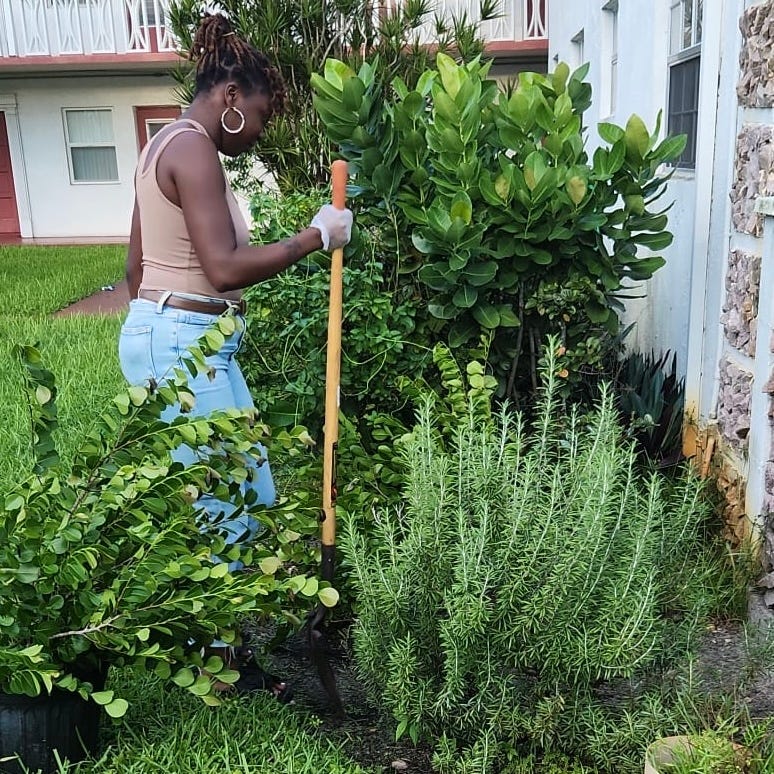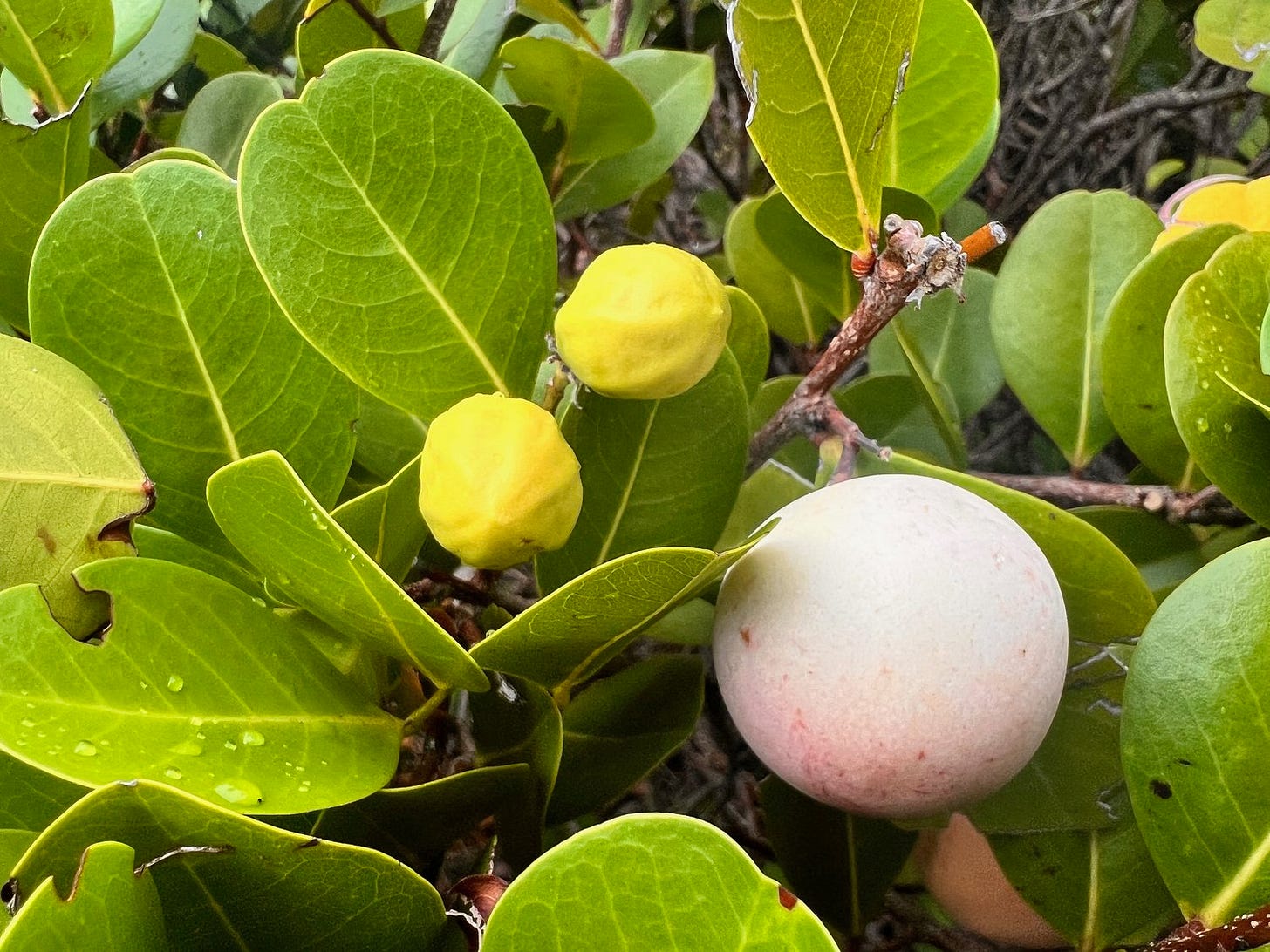Hello Friend,
I’ve been away from my garden for the whole month, embracing winter in New York and Holland. I just returned from celebrating my big sister’s birthday—resting and rejuvenating my soul in the way only time with family can. Of course, everyone overseas was asking the same thing:
“What’s going on over there [in the U.S.]? What are you guys going to do??”
I never have a good answer. My brain does this thing where it just escapes to my garden, like a TV short-circuiting and flipping to another channel. Away from the noise. I close my eyes and suddenly, I’m there:
I can smell the sweet blooms on the mango trees.
I can hear the hummingbirds buzzing around the wildflowers.
I can see the little cocoplums swelling on their branches.
Those cocoplums have been on my mind a lot lately, I’m wishing for a harvest this Spring.
The Cocoplum’s Journey (And My Own)
Last year, I planted cocoplum in a DIY attempt to start a privacy hedge. I wanted something low-maintenance and native. I thought I was making the right choice, but nature had other plans.
The hedge has grown, but not without struggle. Weevils moved in last fall. The plants weren’t as flood-tolerant as I’d hoped. They held on, but they weren’t thriving. So, I decided to do two things:
Plant a hardier species, the clusia.
Get professional help installing the full hedge.
I had assumed native meant naturally resilient, that because cocoplum belonged here, it would flourish here. But the more I learned, the more I started questioning what "native" really means.
Because here’s the thing: cocoplum isn’t just native to Florida. It thrives in the Caribbean, Mexico, South America, and West to Central Africa. When I planted it, I wasn’t just growing a hedge. I was unknowingly planting a piece of home for someone else.
A Plant that Bridges Generations
My Uncle Nathan, the patriarch of my mom’s side of the family, grew up in Sint Maarten, where cocoplums were abundant.
When I told him about my hedge last year, I could hear his face light up over the phone. “You have cocoplum?! I’ve been trying to find one that’s ready to fruit, but I can’t get it anywhere.”
That moment unlocked something, a nostalgia I hadn’t expected.
From then on, whenever we talked, he’d ask, “Did you find me a cocoplum yet?” It became our little side quest. I was to search Facebook Marketplace like I had for my own plants, determined to find one for him. But I waited. A little out of procrastination, but mainly out of care. I wanted to see how mine held up through the brutal summer heat before I passed one along.
When the blossoming season finally came, I brought him the cocoplum shrubs, dug up from my own garden. A piece of home. And perhaps a symbol of a root still finding its way in unfamiliar soil, decades later.
That’s when it hit me:
Maybe native plants aren’t just about where they come from, but about who they belong to.

What Does It Mean to Be Native?
According to the USDA, a native plant is one that “evolved and occurs naturally in a region prior to European settlement.”
But what does that really mean? Native to whom? Native to when?
Cocoplum thrives in St. Maarten just as well as it does in Florida. I imagine all the ancestors, from Africa to the Americas, who cultivated deep relationships with these plants, shaping ecosystems in ways we still benefit from today. How many rituals and cures were rooted in these same branches?
And now, here it is; in my garden. A plant that has traveled across islands and continents, carrying stories across generations, bridging memory with the present.
That cocoplum has managed to thrive in so many places, across so many landscapes.
Much like people, it adapts.
Much like people, it finds a way to belong.
And maybe, that’s the lesson I need right now.
A Rooted Way Forward
As a somewhat third-culture kid, I’ve spent my whole life navigating that tension—of belonging everywhere and nowhere at once.
In today’s world, where citizenship, birthright, and even the idea of home feel precarious, I find myself looking to nature for answers.
And my garden reminds me:
Belonging isn’t about borders; it’s about relationships. It’s about tending to what holds you. It’s about caring for the land and letting it care for you in return.
That feels like something I can root myself in.
And that’s the ethic I’m carrying forward. Not just in my garden, but in the way I care for others, too.
🌺 A HUGE Thank You! 🌺
I want to take a moment to celebrate a milestone: my very first paid subscriber! To that reader (you know who you are!), thank you for believing in this space. Every paid subscription fuels the stories I share here, and I’m beyond grateful.
If you’ve been enjoying Letters from The Safe House and want to support its growth, you can join as a paid subscriber here.
Spotted in the Library 📚
This month, I was featured in a virtual library of Black Substack writers!
Shoutout to for keeping The Cookout Library, a virtual compilation of Black Writers on Substack. If you’re looking for incredible voices across storytelling, culture, and beyond, check out the full library here. It’s an honor to be listed among so many talented writers.
Now, before I go, let’s talk about what’s on deck for the next month…
ICYMI: The Goss is HOT 🌿🗣️🔥
If you missed the latest tea from Garden Gossip 🌿🗣️ … you missed a story! (Think unexpected houseguest. Middle of the night. Heart pounding.) No spoilers, but let’s just say, I was fighting for my life.
📖 Catch up on “Jess vs. The Bedroom Bully” (Paid Subscribers Only)
📸 And if you haven’t seen the latest cover… trust me, it’s a moment.
But here’s where things get even juicier…
I’m taking you behind the scenes in March to show exactly how I bring Garden Gossip 🌿🗣️ to life!
🎬 The first BTS drop lands on March 5. Paid subscribers, get ready.
If you’ve been thinking about subscribing, now’s the time. You’ll get instant access to all the Goss.
✨ Something Special is Coming in March ✨
I have something extra special planned for my birthday, Aries season! It’s something personal. I’ll be revisiting something from my childhood that, in many ways, foreshadowed the life I’m living now.
More on that soon. But for now, I’ll leave you with a question I posed in the subscriber chat.
What’s a plant that means something to you?
Reply, send a comment, join the chat, whatever you prefer. Tell me, I’d love to hear.
Much love,
Jess






You really got me out here about to buy some seeds and get my hands in the dirt cause those plants are truly a source of connection.
Jess - your writing is a balm to my soul. As a wannabe gardener myself, I love your thoughts from the garden. You mention that "Everything I share is all about love," I absolutely feel that in your writing.